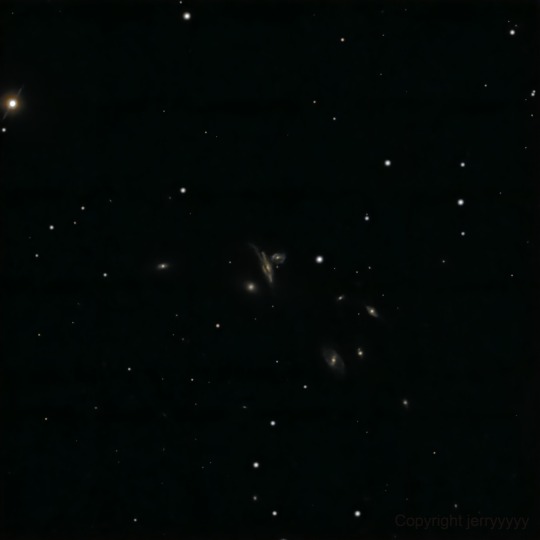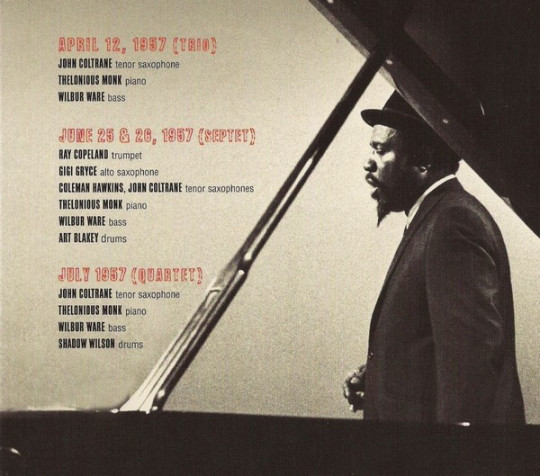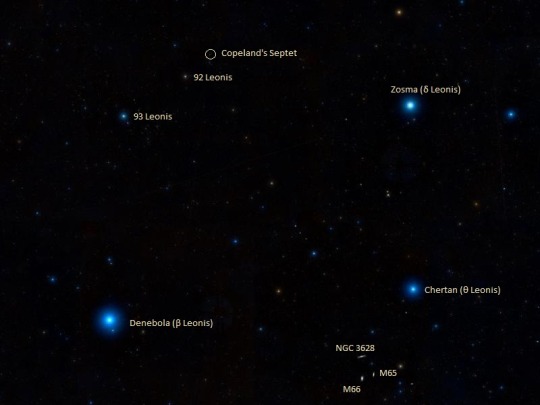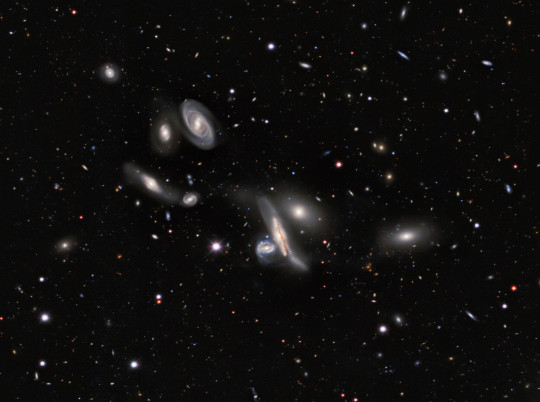#Copeland Septet
Explore tagged Tumblr posts
Text

The Copeland Septet // Jerry Yesavage
#astronomy#astrophotography#galaxy group#HCG 57#copeland septet#galaxy#spiral galaxy#elliptical galaxy#star-forming galaxy#interacting galaxies#NGC 3748#NGC 3754#NGC 3570#NGC 3751#NGC 3745#NGC 3753#NGC 3746#Arp 320#leo
34 notes
·
View notes
Text

Thelonious Monk with John Coltrane
The Complete 1957 Riverside Recordings · Play album
Thelonious Monk (piano), John Coltrane (tenor sax) with Coleman Hawkins (ts), Gigi Gryce (as), Ray Copeland (tp), Wilbur Ware (bass), Art Blakey (d) & Shadow Wilson (d). * Lp info
Tracks 1-1 and 1-2 recorded April 12 1957 (Trio) Tracks 1-3 to 1-6 recorded June 25th 1957 (Septet) Tracks 1-7 to 2-7 recorded June 26th 1957 (Septet) Tracks 2-8 to 2-10 recorded July 1957 (Quartet)

0 notes
Text

Copeland’s Septet

Copeland’s Septet, also known as Hickson Compact Group 57 (HCG 57) and Arp 320, is a group of interacting galaxies located in the constellation Leo. Even though it is called a septet, it is a group of eight, not seven, galaxies that consists of NGC 3748, NGC 3754, NGC 3750, NGC 3751, NGC 3745, NGC 3753, NGC 3746 and PGC 36010. The galaxies are contained within a 5’ area. The group was named after British astronomer Ralph Copeland, who discovered it in April 1874. It lies at an approximate distance of 400 million light years from Earth.
Copeland discovered the group while working for William Parsons, 3rd Earl of Rosse, as an assistant. He discovered the galaxies with the 72-inch Leviathan of Parsonstown, a historic reflector built by Lord Rosse at Birr Castle. The six-foot telescope was the largest telescope in the world between 1845 and 1917, when the 100-inch Hooker Telescope was built at Mount Wilson Observatory in California.
Copeland named the group “The Septet,” describing the galaxies NGC 3745, 3746, 3748, 3750 and 3753 as “pB [pretty bright],” NGC 3751 as “F [faint],” and NGC 3754 as “vF [very faint].”
Dr. Paul Hickson included the group in his Atlas of Compact Groups of Galaxies (1982) as HCG 57. The galaxy PGC 36010 is a member of the group. Other well-known compact galaxy groups catalogued in the atlas include Stephan’s Quintet (HCG 92) and Seyfert’s Sextet (HCG 79).
Copeland’s Septet lies in the eastern part of Leo, above the lion’s tail. The two brightest members can be seen in a 12-inch telescope, but to see all the galaxies one needs a larger instrument.
Further reading: https://www.constellation-guide.com/copelands-septet/?fbclid=IwAR1sQYfEwUwI0vMQ5xFdF_htw9BUYhy7FpYTiL8tt4bIXV4-4GRejQ5ahyQ
17 notes
·
View notes
Text
Pubblicati i dati finali del DESI Legacy Imaging Survey
Pubblicati i dati finali del DESI Legacy Imaging Survey
Un gruppo di galassie soprannominate il Copeland Septet, nella costellazione del Leone. Gli astronomi, utilizzando le immagini dell’Osservatorio Nazionale di Kitt Peak e dell’Osservatorio Interamericano Cerro Tololo, hanno creato la più grande mappa del cielo mai realizzata, che comprende oltre un miliardo di galassie. Utilizzando le immagini ottenute a Cerro Tololo e all’osservatorio nazionale…

View On WordPress
0 notes
Photo

🎹🎼🎶🎵👏🎉 Valiosa Placa ⏺️👏🎉 Thelonious Monk Septet - Monk's Music ⏺️👏🎉 grabado para el sello Riverside Records, el año 1957 ⏺️🔴👏🎉 con Thelonious Monk, al 🎹 👏 🎉 Ray Copeland, a la 🎺 👏 🎉 Gigi Gryce, al 🎷 alto 👏🎉 Coleman Hawkins y John Coltrane, al 🎷 tenor 👏🎉 Wilbur Ware, al bajo 🎸 👏, 🎉 Art Blakey, al Drums 🥁 👏 🎉 🌟 Lee mis artículos sobre La Historia del Jazz 🎺 #arturodelcastilloyap #jaimedelcastillojaramillo #salsaconcausajaimedelcastillojaramillo #salsaconcausalimaperu #abogadounmsmjaimedelcastillojaramillo #abogadojaimedelcastillojaramillo #salsaperújaimedelcastillojaramillo #salsadurajaimedelcastillojaramillo #musicajaimedelcastillojaramillo #hollywoodjaimedelcastillojaramillo #jazzjaimedelcastillojaramillo #guaguancojaimedelcastillojaramillo #musicacubanajaimedelcastillojaramillo #salsalimajaimedelcastillojaramillo https://www.instagram.com/p/BwoA3_0AopO/?utm_source=ig_tumblr_share&igshid=mcvo44o5ioe5
#arturodelcastilloyap#jaimedelcastillojaramillo#salsaconcausajaimedelcastillojaramillo#salsaconcausalimaperu#abogadounmsmjaimedelcastillojaramillo#abogadojaimedelcastillojaramillo#salsaperújaimedelcastillojaramillo#salsadurajaimedelcastillojaramillo#musicajaimedelcastillojaramillo#hollywoodjaimedelcastillojaramillo#jazzjaimedelcastillojaramillo#guaguancojaimedelcastillojaramillo#musicacubanajaimedelcastillojaramillo#salsalimajaimedelcastillojaramillo
0 notes
Photo

THELONIOUS MONK SEPTET Monk's Music. Rare Limited Edition 2004 US Analogue Productions 6-track double LP cut at 45rpm on 180gram Vinyl by AcousTech Mastering, a wonderful audiophile edition of the 1957 classic on Riverside, recorded with Ray Copeland, Gigi Gryce, Coleman Hawkins, John Coltrane, Wilbur Ware & Art Blakey. Comes housed in a deluxe & individually numbered picture sleeve, still in the original custom stickered tearbag which remains unopened. Both vinyl discs are mint & unplayed. Available from https://eil.com/shop/moreinfo.asp?catalogid=711357 #eildotcom #eil #records #vinyl #rarerecords #rarelps #jazz #cratedigging #vinyljunkie #vinylcollection #recordcollection #vinylporn #instavinyl #theloniousmonk https://www.instagram.com/p/BsMQQpGBiY3/?utm_source=ig_tumblr_share&igshid=1f1lgng4u3pj4
#eildotcom#eil#records#vinyl#rarerecords#rarelps#jazz#cratedigging#vinyljunkie#vinylcollection#recordcollection#vinylporn#instavinyl#theloniousmonk
0 notes
Text
Now Playing 4/15
There’s a lot that has been on my plate lately. I have risen from hibernation and would like to share what’s been dominating my playlist.
Kendrick Lamar - DAMN.

KUNG FU KENNY! Hi-YAH. I had the pleasure of experiencing this one with my dear friend, Matt. And what an experience it was. ABSOLUTELY CAPTIVATING. Right after our first listen, Matt and I were pretty quick to agree that this steaming hot album consists of superior lyrical content, high quality production, and masterful dynamic rhythm changes. It’s explosive, gentle, and challenging. Kendrick complements high points of lyrical explosiveness in “DNA.”, “HUMBLE.”, “XXX.” and “DUCKWORTH.” with iconic down-tempo tracks like “YAH.”, “FEEL.”, “LOVE.”, and “FEAR.” The structure of the album is pretty much flawless. At one moment he is in your face and the next he take a small step back to let you breathe, because you need the breath (trust me). Let’s be honest, if the album were 100% as volatile as “DNA.” or “XXX.”, this great big rock we live on would completely implode. I digress... As a whole, the album serves as both a self-portrait of Kendrick, painted with a brush of introspection, and a critical mirror for the world to examine itself. Yet another solid release from K-Dot. This one easily makes it into my top 10 of the year already.
Father John Misty - Pure Comedy

Look at the world around you and carefully observe all human nature and all of its idiosyncrasies. Then, imagine a voice so crisp and sweet that thoughtfully examines those observations through beautifully arranged ballads and folk songs. That is pretty much a summary of my experience with Pure Comedy. He is one of the most insightful, clever, and critical songwriters I have ever heard. On “Ballad of A Dying Man”, he sings about a man on his death bed, who essentially thinks the world revolves around him and his social critique. Later, FJM discusses his ascent to stardom and impending descent in “So I’m Growing Old On Magic Mountain.” Throughout the entire album, he pairs the lyrics nicely with string arrangements, solo piano pieces, sweet acoustic guitar parts, and graceful ballads. This album is hard to resist. Feather Jayhawk Messy, thanks for your humor, social commentary, lyrical genius, and high-caliber vocals.
Additional comment: Some of the lyrics that appear to be hypercritical generalizations of religion are slightly off-putting.
Future Islands - The Far Field

Frontman Sam Herring is easily one of the most engaging and intense singers in my music library. On their new release, Future Islands has definitely not tread new musical terrain. Sometimes I think there’s something missing, but I must admit I get too easily distracted by groovy bass lines and catchy synths that have become their trademark sound. While this new album may lack sonic diversity, I think they make up for it through powerful lyrics. “Ancient Water” is definitely one of my favorites on the album. It has moving lyrics and sticks out musically from the other tracks. The rest of the album has great moments of imagery and passion. It would be pretty sweet to see them live for Sam Herring’s gripping stage presence. Watch him perform online (or better yet, in person) and you’ll see what I mean. Do your thing, Sam!
What’s on my turntable?
Thelonius Monk Septet - Monk’s Music
Absolutely gold vinyl right here. The high-caliber Monk Septet is composed of Monk (piano), Coleman Hawkins (tenor sax), John Coltrane (tenor sax), Gigi Gryce (alto sax), Ray Copeland (trumpet), Wilbur Ware (bass), and Art Blakey (drums). One of the neat features of this record is the inclusion of two versions of “Ruby, My Dear” - one with Hawkins and the other with Coltrane on sax. The narratives and moods are different for each one and help provide a creative distinction. “Off Minor” is definitely one of my favorite tracks off this record.
2 notes
·
View notes
Photo

“Fourth Jailbreaker Arrested With Rose,” Toronto World. January 3, 1909. Page 01. --- William D. Jones Taken in Huntington, W. Va., After Arrival of Inspector Duncan. --- Alex. Rose, the most dangerous of the seven Toronto jail breakers, will be again in the toils in this city tonight.
It also developed after the arrival of Inspector Walter Duncan and Detective Tipton in Huntington, West Virginia, that another of the septet has been captured, namely Wm. D. Jones, alias Williams, who was at the time of the ‘delivery’ being retained along with Budd Copeland for breaking jail in Newcastle, Pa. He was arrested shortly after the arrival of the Toronto detectives, who identified him, and he was last night sent on to Newcastle to stand his trial.
With the capture of Rose and Jones, this makes four of the septet who broke jail last July, who have been heard of.
Only three, however, are in custody, Churchill, who was caught in Texas, having been let go. The others still at large are Ed. Lee, Clark and Copeland. A telegram was received at detective headquarters from Inspector Duncan yesterday afternoon stating that they were leaving at 3 o’clock for Toronto with the prisoner. They will arrive some time this evening.
It is understood that Rose’s identification in Huntington was the outcome of a correspondence between himself and his mother, which has been kept up since his hasty departure from the city. They did not address their letters direct to each other; but it is said thru a medium in the same house, queerly enough, in Hamilton, where Constable Barron was murdered some years ago.
The Hamilton police were notified about the arrest of Rose, or Mitchell as he was known, and they communicated with the local police.
#prison break#fugitive#desperate bandit#toronto jail#toronto police#jail breaker#west virginia#crime and punishment in canada#history of crime and punishment in canada#alex rose#william d. jones#Inspector walter duncan#harry churchill#repeat offender#escaped prisoner#recaptured prisoner#toronto
0 notes
Text
Thelonious Monk: Monk's Music
The summer of 1957 would seem to mark the redemption of Thelonious Monk, the summer he made Monk’s Music in one night.
He was then a 39-year-old New York jazz pianist of great repute who hadn’t been able to work at most jazz clubs in New York for the past six years. His cabaret card, a relic of New York law enforcement since prohibition, had been revoked in 1951 after a spurious narcotics charge. And so he hadn’t been easy to see, which means he might have seemed elusive. He was introverted and sometimes guarded; such behavior has never been unusual in jazz. In fact he lived with bipolar disorder—undiagnosed at the time, though we know about it now, especially through the work of the scholar Robin D.G. Kelley, whose book Thelonious Monk: The Life and Times of an American Original is the principal source of much biographical information here.
At the end of 1955, Monk’s mother, Barbara, had died. In early 1956, an electrical fire destroyed his New York apartment on West 63rd Street, totaling his piano and resulting in his family of five, basically destitute, having to stay for months with friends—15 people in a three-room apartment. At the beginning of 1957, Monk spent three weeks in Bellevue Psychiatric Hospital, taken there by a policeman he'd been unresponsive to after a car accident. (What else was going on in his bloodline? Kelley’s book, at this period, contains a chilling sentence: “Thelonious did not know that his own father had been living in a mental asylum for the past fifteen years.”) In May, his wife Nellie developed an illness which resulted in a thyroidectomy, leaving her frail and depressed, which had a relay effect on Monk. Also during this time, Monk got himself a manager, began a close musical relationship with John Coltrane, made several albums for Riverside records including Monk’s Music, regained his cabaret card, and started a six-month job at the Five Spot Café—a gig which would re-establish his performing career, serve as Coltrane’s finishing school, and be described thereafter as a high point in New York jazz culture.
This is all a relatively easy story to tell. There is a reversal of fortune; Monk makes a great album; he wins. Like any cliche, it only applies badly to Monk.
As a pianist, Monk, who would have turned 100 this year, was not a dazzler-virtuoso like Art Tatum or Oscar Peterson. He phrased in a wide circumference around the beat, leaving a lot of silence in an improvisation, enough for you to notice. He made polytonal clonks on the keyboard by playing the desired note as well as the key adjacent to it. The assumption, often, was that either he didn’t have much technique, or was withholding it because he didn’t want to be understood or known too quickly, and why would someone do that?
A common initial reaction to Monk was skepticism. The pianist Randy Weston, then 18, first saw Monk playing in Coleman Hawkins’ band. “Who is this cat on piano?” Weston remembers thinking, in his memoir African Rhythms. “I can play more piano than this guy!” In other words: it’s unclear what this person knows. Another reaction was humility. The drummer Art Blakey described in a 1973 interview how Monk had been his sympathetic guide through what Blakey called the “cliques” in New York jazz when Blakey first arrived from Pittsburgh in the early ’40s. Blakey watched Monk defend his own music and insist on the right way to play it. “He was very outspoken,” he said. “He knew what he wanted to do, and he did it.” In other words: this person knows a lot.
Much of the talk around jazz, and around Monk, turns on ideas of knowing and not-knowing. (I keep the hyphen, as for related reasons did Donald Barthelme in his essay of that name as well as various Buddhists and psychotherapists, because by “not-knowing” I mean flexibility, working without a fixed outcome, trusting oneself to find a new vocabulary, as opposed to what I would mean without the hyphen: ignorance, lack of awareness, incuriosity.) By one understanding, jazz is a consensual language of rhythm, harmony, and form, and a consensual repertoire accumulated over the last hundred years. That’s about knowing. If you want to work in jazz, you have to get the basic songs under your fingers. Those songs—including, say, “All the Things You Are,” “Donna Lee,” “Footprints,” and about ten by Thelonious Monk—are a part of what holds the tradition together.
The larger part is the fact that jazz is essentially African-American in musical vocabulary and disposition. Jazz is cultural memory. For many African-American musicians, to know is also to be aware of the values and dangers; to know is not to forget. Monk’s music suggested the cumulative past as a wider present: something older from within jazz—boogie-woogie or early Ellington—along with other vernacular traditions adjacent to it: rumba, gospel, or rhythm and blues.
Jazz is further defined by the discipline of improvising, which some say is an express-lane to thinking through time progressively and allowing possibility, the greater idea of not-knowing.
*
From the first seconds of “Well, You Needn’t,” the second track on Monk’s Music and the record’s greatest eleven minutes, much control is in evidence. You hear Monk, with only the bassist Wilbur Ware thrumming in the back, working upward from the C below middle C over an F pedal in half-steps: C, Db, D, Eb, E. Monk is playing in an implied three-beat rhythm, and punching out his notes a little roughly, as you might imagine yourself punching an elevator button. But he is doing it in between the beats, with style and purpose. He climbs his five notes twice, each time bringing you one step away from resolution in a perfect cadence; he is building tension and expectation in a classical and idiomatic way, alerting you that something is going to take place here, and it’s going to be an event. Then it arrives: the song’s hard opening, with John Coltrane, Coleman Hawkins and the rest of the septet piling in, Art Blakey’s drumming shoving it forward.
The band plays the theme together and Blakey crashes on its last beat. Now it’s Monk’s turn. He doesn’t start until the cymbal quiets down, and so for the first measure and a half there is silence. His solo begins as a restatement of the song’s melody, according to convention, but picks it up like a sentence started in the middle. He speeds up and slows down, experimenting, stamping his foot a little, testing the strength of the rhythm and his own relationship to it. Three times he brings his hand down on a strange five-note chord: a stack of fourths, all black notes. Each time he lets it ring for six beats. “Well, You Needn’t” was not a particularly famous song in 1957—Monk had recorded it ten years before for Blue Note, also with Blakey—but it sounds colossal here.
*
Monk wasn’t an album artist per se. Monk’s Music—produced by Orrin Keepnews, recorded at Reeves Sound Studios on East 44th Street, released on Riverside Records—is contradictory: strident, reassuring, fractured, centered. It isn’t perfect, whatever perfect means. Here and there it sounds like a rehearsal or a jam session. Some solos wander, particularly on “Epistrophy,” and the trumpeter Ray Copeland and alto saxophonist Gigi Gryce are comparatively weak links. But Monk’s Music also sounds loose and deep and urgent. At its best it suggests a party in a specific room; you come to know the room. After Monk finishes his solo in “Well, You Needn’t,” he shouts “Coltrane! Coltrane!” to signal who’s up next. Ravi Coltrane, John’s son, told me that when he first heard Monk’s Music he was 21, listening in a university library with headphones on. At Monk’s shout, he startled, thinking someone was looking for him.
The band includes the saxophonist John Coltrane, Monk’s new student, who sounds dry, driven, searching; the saxophonist Coleman Hawkins, Monk’s old mentor, with a gallant and knowing affect that he puts to special use on Monk’s ballad “Ruby, My Dear”; and Blakey, a kind of younger brother, pro-active, explosive, rendering the dance impulse in super-titles. Monk himself does nothing strange by his own standards. He is brusque and vatic and intimate, moving through funny, orderly, supremely affective songs. The first track is the exception in several ways: it is only a melody, played in straight rhythm by the horns alone; it is a hymn called “Abide With Me,” also known as “Eventide,” composed in the middle of the 19th century by the English composer William Henry Monk. Destiny’s Child liked to put their gospel songs at the end of their records; Monk put his at the beginning.
Monk’s Music includes the first renderings of a harmonically rich song that would become one of Monk’s standards, “Crepuscule With Nellie,” written for his wife at a fragile time. Monk plays it unnervingly slowly, and bids the band to do the same with him. (One of his drummers at the time, Frankie Dunlop, in an interview from 1984 extraordinary for the secret knowledge about rhythm it reveals, as well as for Dunlop’s imitation of Monk’s speaking voice, called Monk’s approach to tempo “a different musical category altogether.”) Really, it’s a radical slow dance. During the Five Spot gig, while others soloed, Monk began the practice of dancing on stage: a soft lurch, turning in a circle, imitating the greater circle around the beat.
*
A lot came together for Monk in 1957. Shortly thereafter, starting in the 1960s, he shifted up to touring theaters with a steady band. His records became elegantly repetitive and often staid. He appeared on the cover of Time magazine in 1964; from then on, till his withdrawal from playing in the 1970s and his death in 1982, he was “known.”
You can make fun of jazz writers from the distant past all day, but some of their early published ideas about Monk in the ’40s, especially in Down Beat and Metronome, were only as naïve as Weston’s. If they liked him, they were describing a European-style avant-garde hero, desiring to cut loose from the known. If they didn’t like him, they were describing music they found incomplete or antisocial. They described him as “too too,” “for the super hip alone,” “neurotic,” and—worst of all—“bad, though interesting.” All these reactions imply Monk’s fecklessness or lack of control. They are the reactions of people encountering a critical intelligence and not knowing what to do with it.
Monk’s story is a story of relationships. Born in Rocky Mount, NC, he grew up among Southern and Antillean families at 234 West 63rd Street in Manhattan, on a block now called Thelonious Monk Circle. A couple doors down, No. 224, was the Columbus Hill Neighborhood Center, his social hub and the site of his early gigs. His engagement in the jazz culture of Harlem through the ’40s, alongside Dizzy Gillespie, Bud Powell, and Kenny Clarke, created several new languages in jazz, collectively and roughly described as bebop. All his interviews, all the anecdotes, illustrate that Monk, to a great degree, knew his own value and had no interest in being strange on purpose. (“I don’t like the word ‘weird,’ anyway,” he told Nat Hentoff.) He knew who he was, and that knowledge allowed him the freedom of not-knowing.
One of the best lines in Kelley’s book comes in a secondhand story told by the poet Ted Joans. Be skeptical, but here it is. At some point in the second half of 1957, during a set at the Five Spot, Monk wandered off stage as the band continued to play, out the doors of the club, and walked for a few blocks. One of the club owners chased him down and found him looking at the sky. He asked Monk if he was lost. “No, I ain’t lost. I’m here,” Monk is said to have responded. “The Five Spot’s lost.”
0 notes
Photo

The Copeland Septet // Pulsar59
#astronomy#astrophotography#galaxy group#Copeland Septet#HCG 57#galaxy#spiral galaxy#elliptical galaxy#interacting galaxies#NGC 3748#NGC 3754#NGC 3750#NGC 3751#NGC 3745#NGC 3753#NGC 3746#leo
21 notes
·
View notes
Text
The Copeland Septet is located in the constellation Leo. They are embedded in an asterism that resembles a question mark. In your Goto scope or planetarium program, search for NGC 3753. Here is another image, which seems to show nine galaxies of significant apparent size (from Wikipedia, link below)


The Copeland Septet // Jerry Yesavage
34 notes
·
View notes